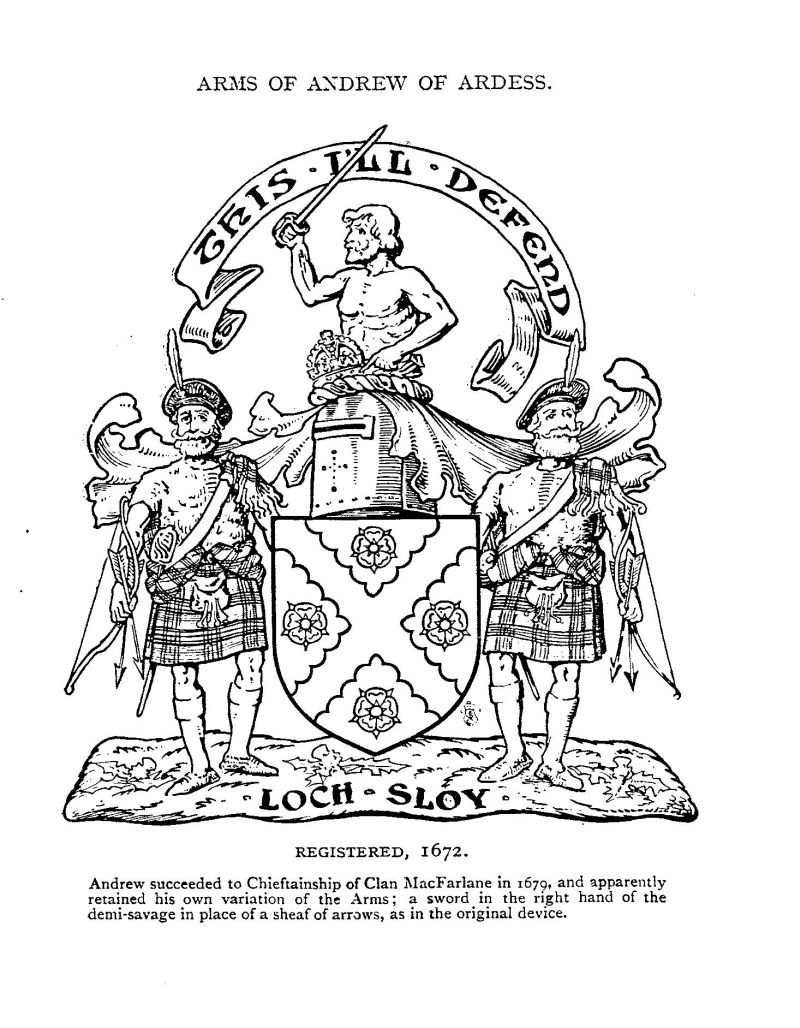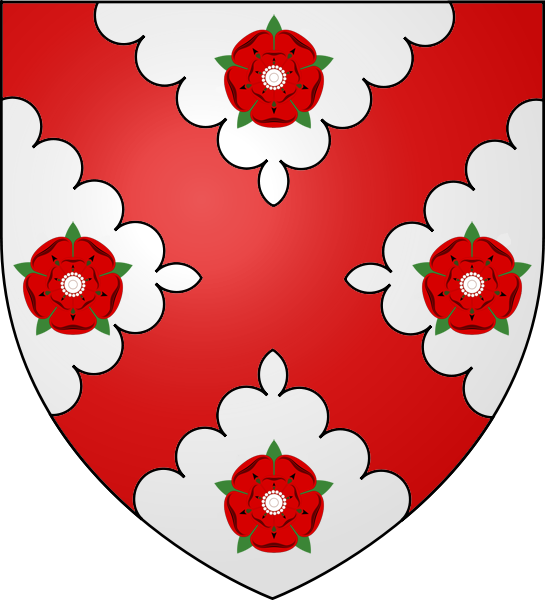MacFarlane Armorial Bearings

The Coat of Arms of MacFarlane of that Ilk and Arrochar
A coat of arms originally referred to the design on a surcoat used to cover the armor of a man in battle. As time went on, the coat of arms became a design that was used on flags, jewelry, plates, etc. and adopted and created by various institutions including universities and societies. Some European countries still maintain the authority that grant and regulate arms. In the case of Scotland, that is the Lord Lyon, King of Arms.
The Blazon (Description) of the Coat of Arms of MacFarlane of that Ilk and Arrochar
Lord Lyon, King of Arms describes a coat of arms in a set manner to provide consistency for all arms. First, the field (basic tincture of the shield); second, the principal charge(s) there upon and their tincture; third, the helmet and its mantling; fourth, the wreath and the crest atop the helmet; fifth, the motto; sixth, the compartment upon which all stands including the supporters which hold up the shield.
First: The field refers to the background tincture (color) on the shield. In the case of the MacFarlane chief’s shield, this is argent (silver), which can be represented as white.
Second: The charge refers to the emblems occupying the field of the shield. This is also called the ordinary. In the case of the MacFarlane chief’s coat of arms, it is the saltire (the diagonal cross of St. Andrew, the patron saint of Scotland who was crucified on a diagonal cross). The cross is engrailed (made up of small concave curves, like tiny waves) to distinguish it from the design used by the ancient earls of Lennox, from whom the MacFarlane chiefs were descended. The cross is gules (red). In each quarter is a red rose, which also derives from the Lennox shield.
Third: The helmet is placed above the shield in a design befitting his Degree, in this case a tilting helm garnished with gold, or the more ancient pot helm garnished with gold. The mantling is the drapery tied to the helmet, which derived from the linen worn by knights over their helmets. It is a cloth of two sides, reflecting the two colors used in the shield, in the case of MacFarlane chief, argent and gules.
Fourth: Atop the helmet rests the wreath, which is a twisted roll of fabric that looks like a rope with six parts, using the first two colors of the shield, again argent and gules.
Above the wreath is the crest granted to Andrew MacFarlane of that Ilk and Arrochar, 11th Chief and 14th Baron, by Moray, the regent of the child king, James VI. This was granted after the Battle of Langside in 1568, where the clan fought successfully against Queen Mary of Scots, his mother.
The crest, as it was originally designed, consists of a demi-savage holding a sheaf of arrows in his raised dexter (right) hand and pointing to the crown of James VI with his sinister (left) hand.
Just over a century later the crest was changed for the then chief, Andrew MacFarlane of that Ilk and Arrochar, 15th Chief and 18th Baron. In the new design, the sheaf of arrows was replaced with a sword.
Fifth: The motto, “This I’ll Defend,” above the crest is referring to the Crown of James VI, who also became James I of England, the first Stewart king of England in 1603.
Sixth: The Compartment is the bottom section of the coat of arms which is placed under the shield. The slogan in the scroll is the MacFarlane rallying cry, “Loch Sloidh” or “Loch Sloy.” Above this is a grassy ground where the supporters stand. It serves as the base for two Highlanders who are the supports for the shield. Scottish law granted Supporters to all clan chiefs and those feudal barons who had a right to a seat in Scottish Parliament before 1597.







